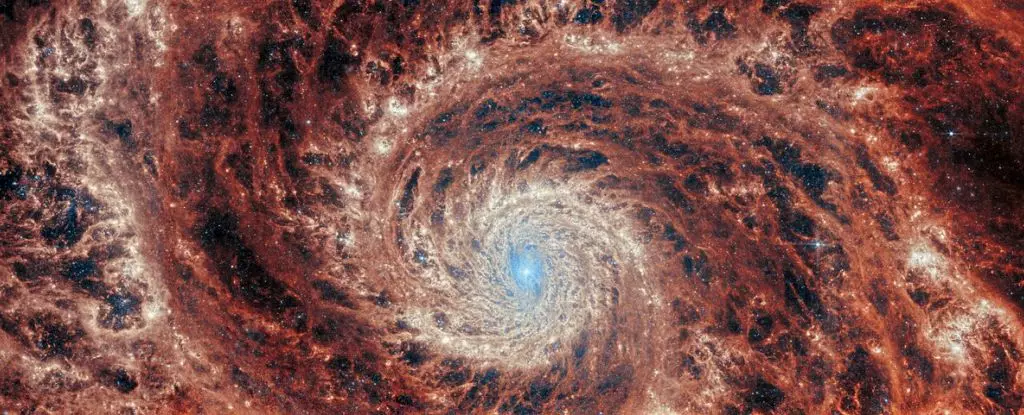The exploration of the cosmos has always captivated humanity, posing profound questions about the origins and evolution of galaxies. Recent findings from the James Webb Space Telescope (JWST) shed light on a pivotal development in our understanding of galactic formation, stretching our comprehension of the Universe’s early days. At the heart of this discovery lies Zhúlóng, an ultramassive grand design spiral galaxy that appears as it was a mere 12.8 billion years ago. This revelation not only challenges prior assumptions regarding the timeline of galaxy formation but also ignites curiosity about the intricacies of cosmic evolution.
The birth of the Universe, represented by the Big Bang, marked an awe-inspiring point in time approximately 13.8 billion years ago. In the aftermath of this cosmic event, matter coalesced over eons, leading to the formation of galaxies. While previous observations indicated that the emergence of structured galaxies occurred over extended periods within the first billion years post-Big Bang, the identification of Zhúlóng suggests an accelerated timeline. Insights from a recent research paper, yet to undergo peer review, argue that galaxies like Zhúlóng demonstrate that complex structures formed far earlier than astronomers had anticipated.
Zhúlóng symbolizes an exceptional specimen of galactic formation, illustrating the primitive architecture of the Universe. Unlike less structured galaxies, such as the roundish lenticular formations, Zhúlóng presents an exquisite grand design spiral structure adorned with captivating, well-defined arms. The prominence of this morphology highlights a pivotal question: when did these stunning spirals first appear in the cosmic tapestry? Investigations reveal that such grand design spirals are exceedingly rare in the deep Universe, almost absent from conditions older than 11.5 billion years.
The unexpected discovery of Zhúlóng emerged from data collated through JWST’s PANORAMIC survey—an ambitious initiative intended to map galaxies from the Cosmic Dawn. While multiple massive galaxies have been uncovered through this survey, the intricate characteristics of Zhúlóng distinguish it from its celestial counterparts. Researchers, led by Mengyuan Xiao of the University of Geneva, describe it as a galaxy with a “striking evolved morphology” possessing a combination of star-forming stellar disks, classical bulges, and dominant spiral arms pressing outward from its nucleus.
One of the most compelling aspects of Zhúlóng lies in its scale, spanning an impressive 62,000 light-years in diameter. Despite its substantial size, the galaxy seems eerily calm, boasting a central black hole that is quiet and a declining star formation rate ranging from 20 to 155 solar masses yearly. This lends credence to the hypothesis that Zhúlóng is not simply a newly formed galaxy teeming with activity, but rather one that has completed the frenzied period of formation and is transitioning to a more stable state.
Redefining Cosmic Chronicles and Intergalactic Relations
The implications of discovering Zhúlóng are momentous. This ultramassive galaxy presents a significant case study for theorizing the mechanisms underlying galaxy formation. More intriguingly, it suggests that galaxies akin to our Milky Way can form much more rapidly than contemporary theories propose—potentially ten times faster than previously documented rates.
As astronomers continue to unravel the complexities of galaxies in the ancient cosmos, Zhúlóng provides critical insights into the Early Universe’s environment and conditions. By scrutinizing its structures and behaviors, researchers can refine models regarding the mechanisms of galactic aggregation and spiral formation, leading to profound shifts in our understanding of cosmic history.
The discovery of Zhúlóng stands as a testament to humanity’s relentless quest for knowledge in unraveling the mysteries of the cosmos. As scientists delve deeper into the evolution of galaxies and their formations, findings like these not only expand our comprehension but also ignite curiosity about the Universe’s vast multiple dimensions. In the grand tapestry of cosmic history, the emergence of structured galaxies like Zhúlóng signifies a turning point, prompting scholars to reconsider established narratives about the development and organization of the Universe. Each insight gained takes us one step closer to deciphering the intricacies of our cosmic origins and the majestic spiral arms that define our galactic neighborhood.

